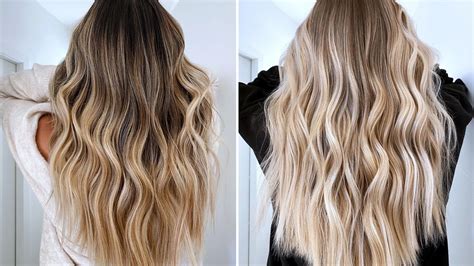Introduction

When seeking a transformative hair makeover, two popular techniques emerge: balayage and highlights. While both aim to enhance hair color, they employ unique methods and yield distinct results. This comprehensive guide will dissect balayage vs highlights, providing an in-depth analysis of their differences and similarities to empower your decision-making.
What is Balayage?
Balayage is a French word meaning “to sweep.” This freehand technique involves painting color onto select strands of hair using a sweeping motion, creating a soft, graduated blend from root to tip. The result is a natural, sun-kissed look that mimics the subtle lightening effects of sunlight.
Key Characteristics of Balayage:
- Freehand application: Color is painted onto the hair without the use of foils or caps.
- Graduated effect: The color transitions seamlessly from darker roots to lighter ends.
- Low-maintenance: Balayage typically requires touch-ups every 6-8 months.
- Versatile: Suitable for most hair types and lengths, offering a wide range of color options.
What are Highlights?
Highlights are created by isolating individual strands of hair and wrapping them in foil or paper before applying bleach or color. This technique results in well-defined streaks of lighter hair that contrast with the base color.
Key Characteristics of Highlights:
- Foil or cap application: The hair is divided into sections and wrapped in foil or a cap to create isolated strands.
- Contrasted effect: The highlighted strands are brighter and stand out from the base color.
- Regular touch-ups: Highlights require more frequent touch-ups, typically every 6-8 weeks.
- Dimensional look: Highlights add depth and dimension to the hair, enhancing its texture and movement.
Balayage vs Highlights: A Side-by-Side Comparison
To further elucidate the differences between balayage and highlights, let us present a detailed side-by-side comparison:
| Feature | Balayage | Highlights |
|---|---|---|
| Application method | Freehand painting | Foil or cap wrapping |
| Blending | Graduated, subtle | Defined, contrasted |
| Maintenance | Low-maintenance (6-8 months) | Regular touch-ups (6-8 weeks) |
| Naturalness | Mimics sunlight effects | Creates bolder, brighter strands |
| Versatility | Wide range of color options | Limited color options (typically lighter shades) |
| Styling options | Enhanced texture and movement | Adds dimension and volume |
| Cost | Typically more expensive | Typically less expensive |
Which Technique is Right for You?
The choice between balayage and highlights depends on your desired outcome and hair type.
Balayage is ideal for those who:
- Prefer a natural, sun-kissed look.
- Seek low-maintenance color.
- Have fine or thin hair that needs added body.
- Desire a versatile color that complements multiple base shades.
Highlights are ideal for those who:
- Want a bolder, more dramatic color transformation.
- Have thick or coarse hair that can handle the chemical processing.
- Seek a defined, dimensional look.
- Prefer a more traditional hair coloring technique.
The Science Behind Balayage and Highlights
Both balayage and highlights involve altering the hair’s pigment through chemical processes.
Balayage:
- Uses low-volume peroxide to lighten the hair.
- The color is blended using a sweeping motion, creating a gradual transition.
- The outermost cuticles of the hair are lifted, allowing color to penetrate.
Highlights:
- Employs higher-volume peroxide to lift the hair to a higher level.
- The hair is isolated in foils or caps to prevent the color from spreading.
- The entire hair shaft is bleached, resulting in brighter, more defined highlights.
Tables for Comparison
Table 1: Application and Maintenance
| Technique | Application | Maintenance |
|---|---|---|
| Balayage | Freehand painting | Low-maintenance (6-8 months) |
| Highlights | Foil or cap wrapping | Regular touch-ups (6-8 weeks) |
Table 2: Naturalness and Versatility
| Technique | Naturalness | Versatility |
|---|---|---|
| Balayage | Mimics sunlight effects | Wide range of color options |
| Highlights | Creates bolder, brighter strands | Limited color options (typically lighter shades) |
Table 3: Styling Options
| Technique | Texture and Movement | Dimension and Volume |
|---|---|---|
| Balayage | Enhanced texture and movement | Adds subtle dimension |
| Highlights | Adds dimension and volume | Creates more defined contrast |
Table 4: Cost and Time
| Technique | Cost | Time |
|---|---|---|
| Balayage | Typically more expensive | May take longer (2-4 hours) |
| Highlights | Typically less expensive | May take less time (1-2 hours) |
FAQs
1. Can I do balayage or highlights at home?
While balayage and highlights can be performed at home, it is highly recommended to visit a professional hairstylist to ensure the best results.
2. Which technique is more damaging to the hair?
Highlights can be more damaging due to the use of higher-volume peroxide.
3. How often should I get balayage or highlights?
Balayage requires less frequent touch-ups, typically every 6-8 months, while highlights require more frequent touch-ups, typically every 6-8 weeks.
4. Can balayage or highlights be done on all hair types?
Both balayage and highlights can be done on most hair types, but it is important to consult with a hairstylist to determine the best technique for your specific hair.
5. How long does balayage or highlights last?
Balayage typically lasts longer than highlights, as the color is gradually blended into the hair.
6. Can I tone balayage or highlights?
Yes, balayage and highlights can be toned to adjust the shade of the color.
Conclusion
Whether you desire a natural, sun-kissed glow or a bolder, more dramatic transformation, both balayage and highlights offer transformative hair coloring techniques. By understanding the differences and similarities between these two methods, you can make an informed decision that empowers you to achieve your desired hair goals.
